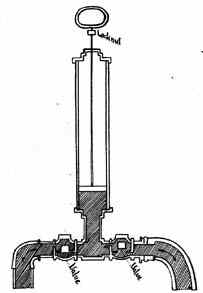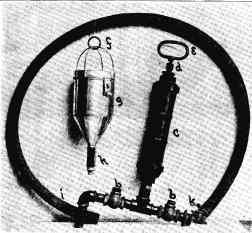
FIGURE 8.--Sectional view of the pump, showing direction of the current as the piston rises.
|
|
CHAS. FORDYCE.
No field of research is more inviting to the
student of science than the one offered by the waters teeming with
minute animal and plant life. Work in this interesting line of
investigation has progressed slowly because of a want of adequate
collecting apparatus, which, until quite recently, has been
limited to two simple types, the net working vertically through
the water and the one working horizontally or obliquely, both of
which present serious disadvantages, prominent among which is the
liability to damage and loss. These nets are of necessity made of
very delicate fabric and must be operated in water where there are
many obstacles to tear and destroy them. The finer qualities of
bolting cloth, of which the better nets are made, cost from $6 to
$8 per yard. To spend this amount for material, a day or two in
constructing the net, and then in the first haul to catch a huge
snag that destroys the net is neither a delightful nor an uncommon
experience.
Secondly, it is impossible to determine with any
degree of accuracy the volume of organisms actually present in a
given quantity of water. This difficulty arises from two causes:
First, the manipulation of the net is attended with such
disturbance as frightens away many of the organisms; secondly, it
is impossible with the net to measure the water filtered. It is
evident that if we wish to ascertain the number of crustacea, for
instance, that exist in a cubic foot of a certain water, we must
first be able to get a cubic foot of the water; with the net we
cannot do this, for even though we know the area of the net
opening it is so constructed and operated as to push aside some of
the water, so that the net does not filter the entire column of
water through which
|
294 |
|
it passes. Thirdly, the plankton is unequally distributed
in the various vertical zones or strata of the water; for
instance, certain groups are characteristic of the surface
stratum, others of the bottom atratum, and still others of the
various intermediate strata. The determination of the various
groups characteristic of these different strata constitutes one of
the most important features of the collector's efforts. It is
evident that with the net we cannot collect the plankton of one
stratum without mixing it with others. Fourth, ice precludes the
use of the net during the winter months, which, in fact. represent
the best season for plankton work.
These, together with other difficulties, have
led students to seek other means of collecting. Among other forms
of apparatus in recent use is the plankton pump. a machine very
similar to the force pump. While the pumping method cannot be said
to eliminate all the disadvantages mentioned, yet we may say that
it reduces these difficulties to a minimum. The. writer determined
last fall to attempt the construction of it light plankton pump
that might be carried about and operated by one person; a simple
plan of construction was suggested by Dr. H. B. Ward. This plan,
with some modifications, finds embodiment in the pump its it now
stands.*
The instrument is practically a force-pump,
whose form and mode of operation are indicated in the accompanying
plates. The cylinder of the pump is 11x 3 1/2 inches and has a
capacity of 347 1/2 cubic inches per stroke. The stroke of the
piston is definite in length and is regulated by a lock-nut as
shown in the plate.The valves used are finely ground check-valves,
to which, it is believed, the accuracy of the working of the
apparatus is largely due. The pump is connected with the water by
a hose 1 1/2 inches in diameter, whose lower end is adjusted to
the various vertical zones of water by means of attachment to a
floating block.
The net was constructed primarily for collecting
crustacea. It consists of a tin cylinder (g, Fig. 9) 6x6
inches, to which is
|
|
295 |
soldered a truncated cone; to the lower end of the conical part is attached the filtering apparatus (h), which is a cylinder 4 x1 1/2 inches, made of fine wire gauze containing eighty-three meshes to the linear inch. The upper portion of the tin cylinder has fitted to it a detachable rim, by means of which a net cover may be attached to the apparatus for the purpose of preventing

FIGURE 8.--Sectional view of the pump, showing direction of the current as the piston rises.
the entrance of objectionable matter. To the rim mentioned are attached the supports (f) as shown in the figure. The filtering apparatus is so constructed that a net of bolting cloth may be attached outside of the gauze filter, thus adapting the instrument (which may be used separately) for the various work
|
296 |
|
of the ordinary net. Most gratifying results have
attended the use of this pumping apparatus during the last few
weeks. It is possible with it to measure with almost absolute
accuracy the amount of water filtered. The average amount of water
thrown at each stroke is 347 1/2 cubic inches. Careful tests show
that the greatest variation above this average is 1.9%, and below
only 1.3%, thus making the extremes between the least and the
greatest amount thrown but 3.2%. The collecting can be carried an
without any disturbance to the water, and the water can be drawn
from any stratum, thus enabling one to get the vertical
distribution of the plankton.
Material has been collected from the midst of
debris and also during the winter months when the water was
covered by a thick coat of ice.

EXPLANATION OF FIGURE 9.
c, Cylinder of pump; e, handle of piston rod;
d, lock-nut; b, check valves; k, attachment of hose;
i, distal end of hose; g, cylinder of net; h, filtering apparatus;
f, support.



© 2000, 2001 for NEGenWeb Project by Pam Rietsch, T&C Miller